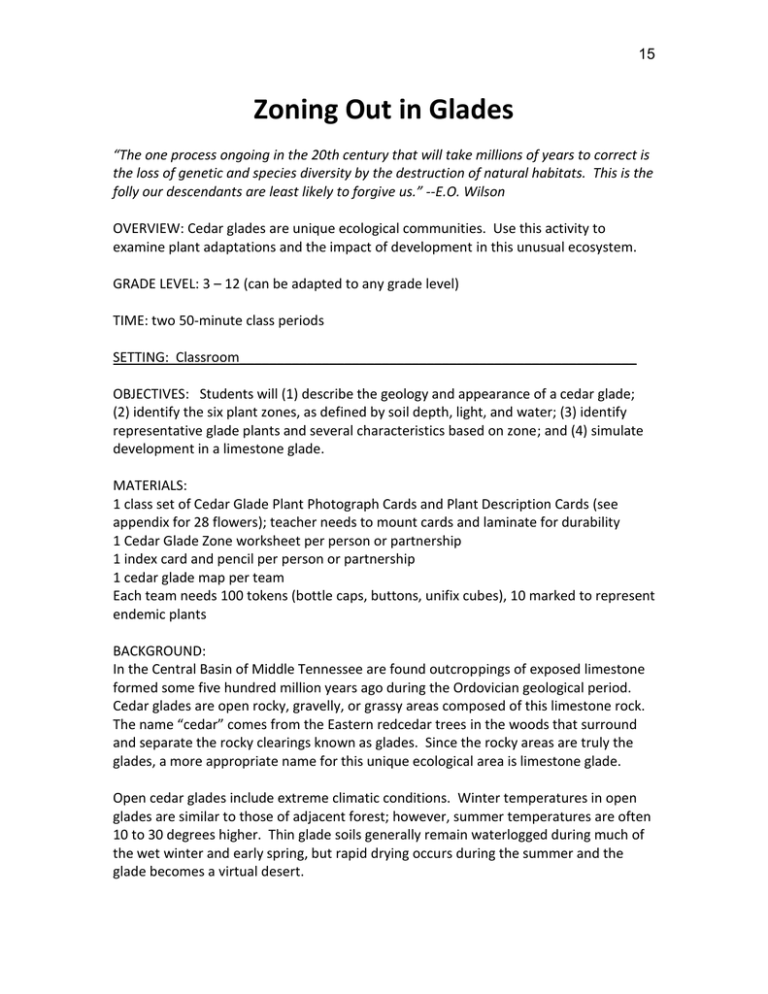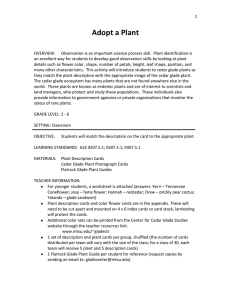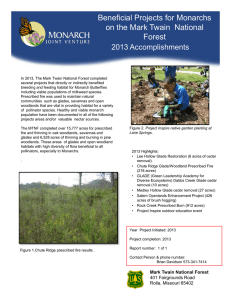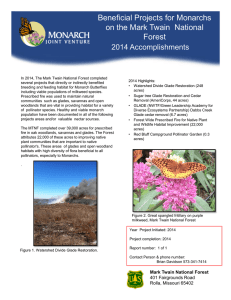Zoning Out in Glades
advertisement

15 Zoning Out in Glades “The one process ongoing in the 20th century that will take millions of years to correct is the loss of genetic and species diversity by the destruction of natural habitats. This is the folly our descendants are least likely to forgive us.” --E.O. Wilson OVERVIEW: Cedar glades are unique ecological communities. Use this activity to examine plant adaptations and the impact of development in this unusual ecosystem. GRADE LEVEL: 3 – 12 (can be adapted to any grade level) TIME: two 50-minute class periods SETTING: Classroom_____________________________________________________ OBJECTIVES: Students will (1) describe the geology and appearance of a cedar glade; (2) identify the six plant zones, as defined by soil depth, light, and water; (3) identify representative glade plants and several characteristics based on zone; and (4) simulate development in a limestone glade. MATERIALS: 1 class set of Cedar Glade Plant Photograph Cards and Plant Description Cards (see appendix for 28 flowers); teacher needs to mount cards and laminate for durability 1 Cedar Glade Zone worksheet per person or partnership 1 index card and pencil per person or partnership 1 cedar glade map per team Each team needs 100 tokens (bottle caps, buttons, unifix cubes), 10 marked to represent endemic plants BACKGROUND: In the Central Basin of Middle Tennessee are found outcroppings of exposed limestone formed some five hundred million years ago during the Ordovician geological period. Cedar glades are open rocky, gravelly, or grassy areas composed of this limestone rock. The name “cedar” comes from the Eastern redcedar trees in the woods that surround and separate the rocky clearings known as glades. Since the rocky areas are truly the glades, a more appropriate name for this unique ecological area is limestone glade. Open cedar glades include extreme climatic conditions. Winter temperatures in open glades are similar to those of adjacent forest; however, summer temperatures are often 10 to 30 degrees higher. Thin glade soils generally remain waterlogged during much of the wet winter and early spring, but rapid drying occurs during the summer and the glade becomes a virtual desert. 16 It is not surprising that glade plants, like many desert plants, have special means of coping with hot, dry summers. Plants growing in the thinnest soils have very shallow roots and are small in size. Many glade plants flower early in spring and set seed before conditions become unfavorable. Others produce numerous seeds and a have life cycle that is completed quickly. Some glade plants are perennials, with thick underground stems or bulbs that store food. Still others survive by having long roots that tap water from soil beneath the rock or by storing water in succulent leaves. Other adaptations include the plant’s inability to be used as a food source for animals or the production of chemical substances that inhibit the growth of other plants. The factors that influence the location of a plant in the glade include light intensity, temperature, and soil depth (which affect available moisture). Over long periods of time, each species comes to occupy its particular position along the ecological spectrum as plants compete for the same resources in the glade. Six plant zones are recognized based primarily on soil depth. Gradual transitions in several environmental factors are apparent, as illustrated below: Open glade high high increase decrease shallow low ZONE 1 exposed rock SOIL DEPTH Glade woods low low LIGHT INTENSITY TEMPERATURE decrease increase SOIL DEPTH AVAILABLE MOISTURE 2 gravelly glades (0 - 2”) 3 grassy glades (2 - 8”) 4 shrubs (8 - 12”) deep high 5 cedar woods (> 12”) 6 oak-hickory forest (>12”) Limestone glades are home to 23+ plants found nowhere else in the world. These plants are referred to as endemic species. One of the most well known is the Tennessee Coneflower which received federal listing as an endangered species in 1979. In nature, it is restricted to only four sites in the world. The only way to protect this plant is to protect its habitat. Unfortunately, limestone glades have been used as garbage dumps for years by local residents and development continues to threaten glade habitat. In an effort to protect these rare plants, the Tennessee Division of Natural Areas and the Tennessee Nature Conservancy have purchased large tracts of glade property to maintain as preserves. 17 PROCEDURE for FIRST PART OF ACTIVITY: 1. Describe the cedar glade ecosystem. Discuss the characteristics of glade plants in relationship to the basic requirements of sun, soil, water, and nutrients. Discuss the six plant zones, as defined by soil depth, light, and available moisture. Introduce the term “endemic species” which are species that exist only in a particular area and nowhere else in the world. To check for understanding, ask students to complete the cedar glade zone worksheet. 2. Depending on how many flower cards you have created, students can work individually or as partners in teams of four to six. Distribute plant photograph cards and plant description cards to student teams based on zone grouping (see plant descriptions for this information – it is helpful to color code the cards with stickers – all zone 2 plants have a yellow sticker). For example, team one will receive plants that are only found in zone 2. Do not tell the students that they are clustered by zone at this point in time. 3. Instruct the students to take 5 minutes to read and study their plant. As they study their plant, they need to list the following information on their index card: Flowering time, plant size, any unique feature in the roots, stems, leaves, note if it is endemic or not, and the glade zone. 4. Students will share and compare their plants in their team. Similarities will be noted and students will compile a “master” list of similarities for that team on the other side of the index card. Students should realize at this point in time that all the plants in their team are in the same glade zone. Their plants collectively, have adaptations representative of their zone. 5. To learn about plants from other zones, students will distribute themselves into new teams composed of plants from different zone groups – the teacher may need to assist with this but it is important that the new groups represent different zones. In the ‘mixed zone’ team, students will share their plant and zone characteristics. Once all members have shared their plant and an explanation of the zone in which it occurs, each student will plot their plant in the appropriate zone on a glade map provided to that team. 6. When all members of each ‘mixed zone’ team have plotted their plant in the appropriate zone, each team will rotate their map to another team. They in turn, will receive a map from another team and repeat the plotting exercise. When all the teams have plotted their plants on all the maps, the original map is returned to each team. It will now contain all the glade plants for the entire class, with each plant plotted in the appropriate zone. 7. Glade teams will then evaluate their maps. To evaluate the flower card information that students have gathered, ask these questions: What zone(s) have the greatest number of plants? Why? (Answers will vary 18 because only a small number of plants were selected, primarily the endemics.) What zone(s) have the greatest number of endemic plants? Why? (zone 2 and 3 have the greatest number of endemics; glade plants in these zones have evolved adaptations to survive with little soil, moisture, high temperatures, and light.) Why are plants not found in zone 1? (plant roots need soil to grow) What prevents the cedar forest from growing in the glade clearing? (the rock) What zone had the tallest/smallest plants? (plant height and root depth are usually proportional, zone 2 has little soil depth to support the root system of a tall plant) PROCEDURE for SECOND PART OF ACTIVITY: 8. To continue to the second part of this activity that demonstrates the impact of development in glades, Instruct students that they have inherited 100 acres of Limestone Glade! To prepare for this activity, they will arrange tokens over their cedar glade map with the flower names written on it, in a 10 by 10 grid (10 rows with 10 columns). The tokens represent plant populations in their glade. If students inquire about the 10 tokens with special marks, instruct them to place them where ever they choose but do not tell them at this time that the marked tokens represent endemic plants. It is important these tokens are randomly placed but they are an important part of the evaluation at the end of the activity. 9. As a landowner, instruct the student to remove 10 to 20 tokens to build a road through the glade. Keep the removed tokens in a pile marked “road.” 10. Development will continue – ask the students to remove 4 tokens for each house they plan to build on their glade. Place those tokens in a pile marked “houses.” 11. Explain that with houses and a road it would be nice to have a place to shop, instruct students to remove 8 to 12 tokens for a store. Place those tokens in a pile marked “store.” 12. To determine the percent of plant populations removed as a result of development, ask students to calculate this value. Approximately 5% of the identified plants in glades are endemic (23+ species out of 400+ species identified in glades). For younger students, use 10 marked tokens; older students, use 5 marked tokens. Do not tell them until now that the marked tokens represent endemic plants. We don’t know how long it takes to create a cedar glade, once destroyed. Ask these questions: What percent of endemic plants did they remove to develop their glade? (this number will vary per team) What could they do differently if they knew about rare plants on their land? (this is the heart of the issue of land management, trying to use resources wisely and protect the existing organisms) What is the price of progress? (Responses will vary from student to student, but we have heard a great deal about protecting the rainforest – this is an opportunity to talk about protecting an ecosystem in their own backyard.) 19 Name____________________________ Cedar Glade Zones This is a model developed by cedar glade scientists to explain and display the relationship of light intensity, temperature, soil depth, and available moisture relative to each zone in the glades. To check your understanding, answer the following questions: Identify the light, temperature, soil depth, and available moisture in Zone 1. Identify the light, temperature, soil depth, and available moisture in Zone 3. Identify the light, temperature, soil depth, and available moisture in Zone 6. Open glade high high increase decrease shallow low ZONE 1 exposed rock SOIL DEPTH LIGHT INTENSITY TEMPERATURE Woods around Glade low low decrease increase SOIL DEPTH AVAILABLE MOISTURE 2 3 4 gravelly glades (0 - 2”) grassy glades (2 - 8”) shrubs (8 - 12”) deep high 5 cedar woods (> 12”) 6 oak-hickory forest (>12”) 20




